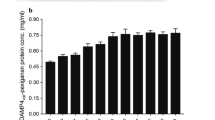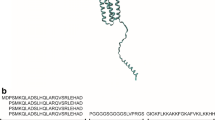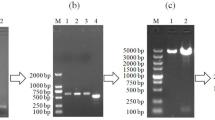Abstract
Antimicrobial peptides (AMPs) are extremely attractive candidate for therapeutic agents due to their wide spectrum of antimicrobial activity and action mechanism different from antibiotics. In this study, a method using genetic engineering for obtaining an antimicrobial peptide, bovine lactoferricin derivative peptide LfcinB-W10, has been developed. According to the coden usage of Escherichia coli, a gene encoding the peptide was synthesized and a recombinant vector of E. coli expression pGEX-EN-LFW was constructed. The LfcinB-W10 peptide fused with glutathione S-transferase (GST) was successfully expressed and about 20 mg fusion protein with 90% purity was obtained from 1 l culture. The recombinant LfcinB-W10 (rLfcinB-W10) was released from fusion protein by the enterokinase digestion, and about the LfcinB-W10 yield reached 300 μg per 1 l culture. The purified rLfcinB-W10 was found to have growth inhibition activity against Staphylococcus aureus (S. aureus) ATCC25923.





Similar content being viewed by others
References
Andersen JH, Jenssen H, Gutteberg TJ (2003) Lactoferrin and lactoferricin inhibit Herpes simplex 1 and 2 infection and exhibit synergy when combined with acyclovir. Antiviral Res 58:209–215
Andersen JH, Jenssen H, Sandvik K et al (2004) Anti-HSV activity of lactoferrin and lactoferricin is dependent on the presence of heparin sulphate at the cell surface. J Med Virol 74:262–271
Bradford MM (1976) A rapid and sensitive method for the quantitation of microgram quantities of protein utilizing the principle of protein–dye binding. Anal Biochem 72:248–254
Cabral KMS, Almeida MS, Valente AP et al (2003) Production of the active antifungal Pisum sativum defensin 1 (Psd1) in Pichia pastoris: overcoming the inefficiency of the STE13 protease. Protein Expr Purif 31:115–122
Dawson RM, Liu CQ (2008) Properties and applications of antimicrobial peptides in biodefense against biological warfare threat agents. Crit Rev Microbiol 34(2):89–107
Feng XJ, Wang JH, Shan AS et al (2006) Fusion expression of bovine lactoferricin in Escherichia coli. Protein Expr Purif 47:110–117
Gifforda JL, Huntera HN, Vogela HJ (2005) Lactoferricin: a lactoferrin-derived peptide with antimicrobial, antiviral, antitumor and immunological properties. Cell Mol Life Sci 62:2588–2598
Haug BE, Svendsen JS (2001) The role of tryptophan in the antibacterial activity of a 15-residue bovine lactoferricin peptide. J Pept Sci 7:190–196
Liang YL, Wang JX, Zhao XF et al (2006) Molecular cloning and characterization of cecropin from the houseXy (Musca domestica), and its expression in Escherichia coli. Dev Comp Immunol 30:249–257
Racie LAC, McColgan JM, Grant KL et al (1995) Production of recombinant bovine enterokinase catalytic subunit in Escherichia coli, using the novel secretory fusion partner DsbA. Biotechnology 13:982–987
Saito A, Ueda K, Imamura M et al (2004) Purification and cDNA cloning of a novel antibacterial peptide with a cysteine-stabilized alphabeta motif from the longicom beetle, Acalolepta luxuriosa. Dev Comp Immunol 28:1–7
Schagger H, von Jagow G (1987) Tricine-sodium dodecyl sulfate-polyacrylamide gel electrophoresis for the separation of proteins in the range from 1 to 100 kDa. Anal Biochem 166:368–379
Stoletzki N, Eyre-Walker A (2007) Synonymous codon usage in Escherichia coli: selection for translational accuracy. Mol Biol Evol 24:374–381
Strøm MB, Rekdal O, Svendsen JS (2000) Antibacterial activity of 15-residue lactoferricin derivatives. J Pept Res 56:265–274
Strøm MB, Haug BE, Rekdal O et al (2002) Important structural features of 15-residue lactoferricin derivatives and methods for improvement of antimicrobial activity. Biochem Cell Biol 80:65–74
Wu M, Hancock RE (1999) Interaction of the cyclic antimicrobial cationic peptide bactenecin with the outer and cytoplasmic membrane. J Biol Chem 274:28–35
Yu KH, Kim KN, Lee JH et al (2002) Comparative study on characteristics of lysozymes from the hemolymph of three lepidopteran larvae, Galleria mellonella, Bombyx mori, Agrius convolvuli. Dev Comp Immunol 26:707–713
Zasloff M (2002) Antimicrobial peptides of multicellular organisms. Nature 415(6870):389–395
Acknowledgements
This work was supported by the grants from National Natural Science Foundation of China (No. 30800794), Youth Science Funds of Heillongjiang Province (No. QC08C05) and Research Foundation of Northeast Agricultural University.
Author information
Authors and Affiliations
Corresponding authors
Additional information
Xingjun Feng and Chunlong Liu contributed equally to this work.
Rights and permissions
About this article
Cite this article
Feng, X., Liu, C., Guo, J. et al. Expression and Purification of an Antimicrobial Peptide, Bovine Lactoferricin Derivative LfcinB-W10 in Escherichia coli . Curr Microbiol 60, 179–184 (2010). https://doi.org/10.1007/s00284-009-9522-8
Received:
Accepted:
Published:
Issue Date:
DOI: https://doi.org/10.1007/s00284-009-9522-8




